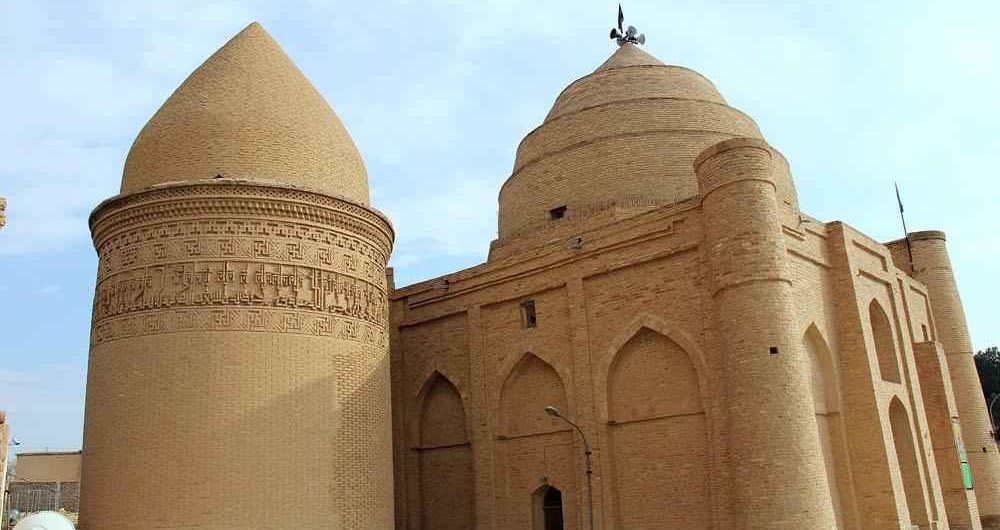Damghan
It is the capital of the Damghan district in Semnán province, Iran. This city, called Sad Darvazeh (City of Hundred Gates), was the capital of the Arsacid empire. In Greek texts, the name of this city was Hacatopolis. Given its privileged geographical location, Damghan stretches from Alborz in the north to the desert in the south. This historic city is rich in natural and historical attractions and attracts many visitors who manage to reconcile their interest between the mountains and the desert. Semnán was a major endpoint on the Silk Road. Therefore, both in the city and along the way there are still many architectural elements, caravanserais, mosques, bazaars and the famous desert lighthouses. Headlights marked the direction of caravans traveling on dark nights.
Damghan is the second largest pistachio-producing city in Iran and a large part of its economy depends on the production of pistachios. The pistachio processing and production units of Damghan, located 30 km north of the city, which thanks to its fertile land and pleasant climate, have become the main industries and occupations of the inhabitants of Damghan.
Cheshmeh Ali
It is one of the permanent springs of Damghan, located 30 km north of the city, which thanks to its fertile land and pleasant climate, has been frequented since ancient times. During the Qajar period, many buildings were built around Cheshmeh Ali, such as the palaces of Fath Ali Shah and Agha Mohammad Khan, which still exist. The Palace of Fath Ali Shah is built in the middle of a lagoon located between the first and the second springs and the Palace of Agha Mohammad Khan is located in front of the old palace.
Tarikhané
In Damghan there is an exceptional example of an old Iranian mosque. The architecture of this mosque is reminiscent of the Firuz Abad castle, quite comparable to the Sassanid monuments. This mosque is the first minaret mosque in Iran. The main minaret, with a rectangular base, was rebuilt in the Seljuk period and other minarets were added. Tarikhané, made up of two words in Turkish and Persian, means house of God.
Caravanserai on the Silk Road between Nishapur – Damghan – Semnán
Caravanserai were facilities built to house caravans between cities and on the main roads of Iran and the Silk Road. The construction of many caravanserais dates back to the Safavid period of the 16th century AD. Those were built with a square or rectangular plan, and their architecture and materials were influenced by the architectural style of each era. Caravanserai are classified into several categories according to their style of construction. In general, in these two: suburban and urban. On the way to Nishapur or Tehran, many of these beautiful places can be seen, including the largest in the whole country, which still exists in this region and is called the Miandasht Caravanserai – a unique complex, in which a small caravanserai it has been added to the others over time. The Miandasht complex highlights a particular structure that includes all the necessary elements to accommodate both the kings and the caravans. Within the complex there are cisterns, halls, rooms, stables, warehouses, etc.
Pir-e Alamdar Tower
East of Damghan, in the Khuriya district, there is a beautifully decorated tomb. The Pir-e Alamdar mausoleum is designed as a circular, cylindrical tower with a double-domed cupola. A man named Mohammed ibn-e Ibrahim, known as Pir-e Alamdar, ruler of the state of Ghumez, is buried in this tomb. The rectangular frame of the entrance, with bricks and a Kufic inscription, attracts the attention of all lovers of art and history. At the top, seven bands of bricks surround the tower, which in turn has been decorated with bricks placed in different positions creating very curious geometric shapes.
Ramli Desert
South of Damghan, a sandy desert stretches to the town of Yazdan Abad, 75 km from the city. It is one of the main natural attractions of Damghan. There are yellowish sands exposed to the sun that flow with the strong winds and form dunes. When there is a storm, the flowing sand creates a wavy scene like the surface of the sea.
If you are passionate about mountains, desert, the Silk Road, popular markets, hiking, photography, nomadism, desert, anthropology, historical landscapes and the fascinating culture of the Middle East, SITO Travel will help you organize your trip to Iran. Contact us because our experience is born and developed in the field.
Excursion to Chehel Dokhtar
The story is about the refuge of 40 girls who escaped from the threats of the invaders traveling through many countries in order to find refuge in a safe city, far from danger. The enemy pursued them, but failed to stop them. Since then and according to this legend, many towers or fortresses are called “Chehel Dokhtar” or “Chehel Dokhtaran”, which means “forty girls”. The story is not only popular in Iran, but also in Afghanistan, Uzbekistan, Tajikistan, and even Turkey, where buildings with this name can be found.
However, the history of Damghan’s Chehel Dokhtaran tower is considered to be related to a Zoroastrian fire temple built before Islam. Some believe that this tower was built, with materials such as clay and adobe, by forty girls who abandoned their secular possessions.



Comments